�
�
�
�
�
�
� (This article appeared in Volume XI Issue 3, September 2003.)�
� Long-time readers of the Newsletter may remember that several times over the last five years or so, � I have claimed that I was on the threshold of an MGA V8 project. Due to a combination of increased � hours required at my job, a home relocation, assisting my father in building and moving into a new � home (400 feet behind mine) and other factors the MGA shell and chassis have been sitting untouched � and forlorn. However, circumstances have finally combined to allow the project's initiation. First � on the agenda will be building the MGA's engine, as it will temporarily replace the worn out Olds � 215 in my '74 MGB. After a season's tuning and break in, the new engine will be pulled and stored � until the "A" is ready.�
�
�
�
�
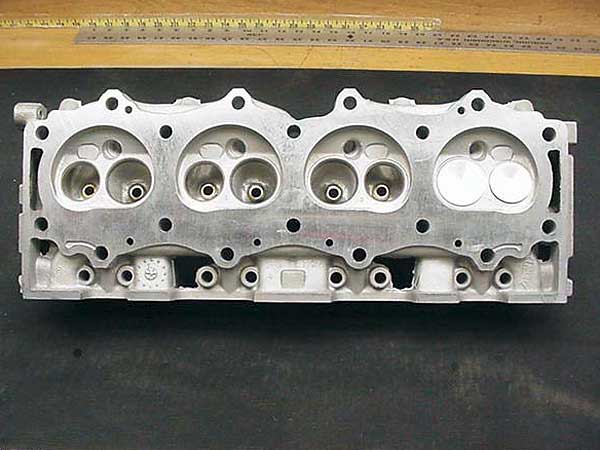 �
�
Oldsmobile "215" Stroker Motor (289 cid) - Part 1
� By: Kurt Schley �� (This article appeared in Volume XI Issue 3, September 2003.)�
� Long-time readers of the Newsletter may remember that several times over the last five years or so, � I have claimed that I was on the threshold of an MGA V8 project. Due to a combination of increased � hours required at my job, a home relocation, assisting my father in building and moving into a new � home (400 feet behind mine) and other factors the MGA shell and chassis have been sitting untouched � and forlorn. However, circumstances have finally combined to allow the project's initiation. First � on the agenda will be building the MGA's engine, as it will temporarily replace the worn out Olds � 215 in my '74 MGB. After a season's tuning and break in, the new engine will be pulled and stored � until the "A" is ready.�
�
�
I had originally planned a stock displacement Olds 215 with longer connecting rods, i.e. Buick 300. �
There are several advantages to a long-rod engine. I had collected most of the components for this �
engine when fate intervened in the form of a phone call from Dan LaGrou at D&D Fabrications. �
Dan had purchased an Olds stroker motor and had everything except the heads available. It seems that �
the engine was originally built many years ago to power a racing hydroplane boat (for which the 215 �
engine was a popular mill). The engine was apparently built, run on a test stand or a dyno only once �
for a short period of time, never installed into the hydroplane, and stored. Eventually the boat and �
engine's owner passed away and the combination was purchased by a fellow in Arizona. The new owner �
had no plans to use the aluminum V8 and contacted Dan. When the motor eventually made it to the �
D&D shop in Michigan, it was pretty much an unknown entity. The heads were found to have been �
extensively ported and were soon shipped off to one of Dan's customer's, leaving the balance of the �
engine on the engine stand.�
� When the heads and oil pans were removed, the long block turned out to be a treasure trove of mid-sixties � Mickey Thompson speed parts. A 3-3/4" welded crank (yielding 289 cubic inches), boxed connecting rods, � M/T pistons, roller cam and roller lifters, reinforced cam gears, and a block machined for the crank and � rod clearances. The main bearing caps are reinforced with massive steel supports about an inch thick. � The pistons show just a hint of heat tint, evidence of only a few minutes running time.�
� Over the next few months, I will be going over each component of the engine, measuring, cleaning and � improving where feasible. For instance, the roller cam is an unknown. I will have to have it "mapped" � by a cam expert to figure out the specs and whether it is suitable for street use. The progress of this � project will be documented for the Newsletter (Actually, I have mixed emotions about even using all � these neat vintage parts in a running motor, due to their rarity. They would look great on the � fireplace mantle!).�
��
�
� Being that the engine came to me with no heads, I decided this would be the first problem to be � addressed. The Buick/Olds 215, as well as the Rover, V8's, are well known to be head restricted. � That means the port size/configuration and the rather smallish valve diameters will not allow � sufficient fuel/air flow to make real power. Even mild porting, while entirely worthwhile, will � not allow the engine to breath enough to reach full potential. I could have used modified later � Rover heads, but this would have created problems with the valve train and with compression. The � pistons/compression ratio were set up for the 51cc (casting suffix -746) low-compression Olds heads. � Using Buick/Rover heads with their 37cc chambers, would have resulted in a compression ration in � excess of 11.5:1. So, the heads would have to remain Olds 215, but would require extensive reworking � in order to support 289" cid. One favorable factor is that the long stroke will dictate a rather � low maximum RPM, somewhat lessening the flow requirements for the heads.�
�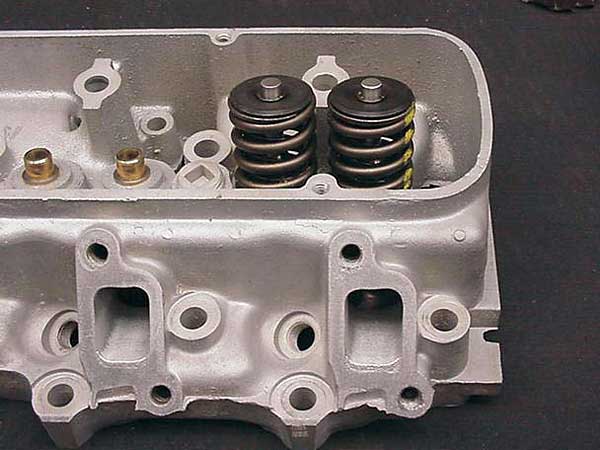 �
�
�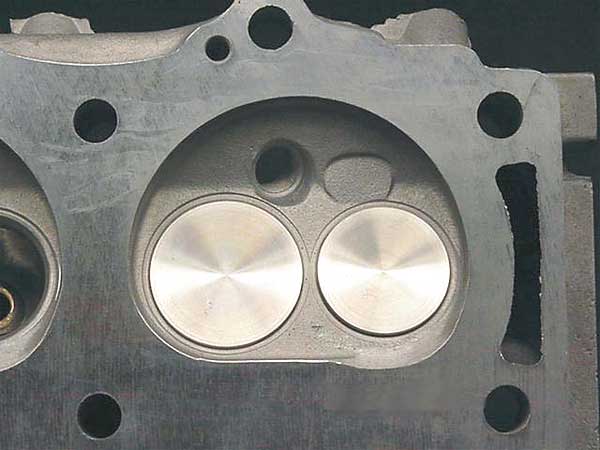 �
�
�
�
�
� When the heads and oil pans were removed, the long block turned out to be a treasure trove of mid-sixties � Mickey Thompson speed parts. A 3-3/4" welded crank (yielding 289 cubic inches), boxed connecting rods, � M/T pistons, roller cam and roller lifters, reinforced cam gears, and a block machined for the crank and � rod clearances. The main bearing caps are reinforced with massive steel supports about an inch thick. � The pistons show just a hint of heat tint, evidence of only a few minutes running time.�
� Over the next few months, I will be going over each component of the engine, measuring, cleaning and � improving where feasible. For instance, the roller cam is an unknown. I will have to have it "mapped" � by a cam expert to figure out the specs and whether it is suitable for street use. The progress of this � project will be documented for the Newsletter (Actually, I have mixed emotions about even using all � these neat vintage parts in a running motor, due to their rarity. They would look great on the � fireplace mantle!).�
�
| �
Enjoying this article? Our magazine is funded through the generous support of readers like you! � To contribute to our operating budget, please click here and follow the instructions. � (Suggested contribution is twenty bucks per year. Feel free to give more!)� |
� Being that the engine came to me with no heads, I decided this would be the first problem to be � addressed. The Buick/Olds 215, as well as the Rover, V8's, are well known to be head restricted. � That means the port size/configuration and the rather smallish valve diameters will not allow � sufficient fuel/air flow to make real power. Even mild porting, while entirely worthwhile, will � not allow the engine to breath enough to reach full potential. I could have used modified later � Rover heads, but this would have created problems with the valve train and with compression. The � pistons/compression ratio were set up for the 51cc (casting suffix -746) low-compression Olds heads. � Using Buick/Rover heads with their 37cc chambers, would have resulted in a compression ration in � excess of 11.5:1. So, the heads would have to remain Olds 215, but would require extensive reworking � in order to support 289" cid. One favorable factor is that the long stroke will dictate a rather � low maximum RPM, somewhat lessening the flow requirements for the heads.�
�
 �
�
�
 �
�
�
�
Participants of the past MG V8 Conventions know Dale Spooner. Dale has been a V8'er for many years �
and one of the first builders to have put together a well handling Ford 302 small block MGB. In �
addition, Dale is the proprietor of one of New England's premier engine machine shops, Motion �
Machine in South Burlington, VT. Motion Machine specializes in the precision machining required for �
successful high performance and exotic engine building. Many other machine shops routinely send their �
difficult work over to Dale, such as four valve/cylinder heads, Ferrari and other exotics, as well as �
rectification of other's bungled jobs. For high performance head work, Dale works closely with Dwayne �
Porter, a master porting and high performance head expert. Dwayne has his flow bench and porting �
equipment in the Motion Machine facilities.�
�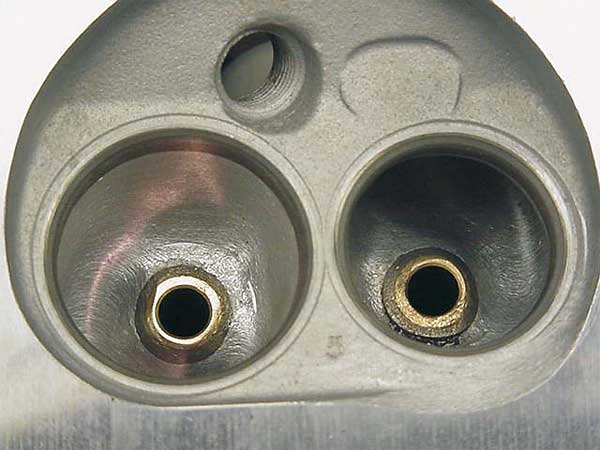 �
�
� In conversations with Dale, it was decided to send a set of Olds heads up to him, so that he and � Dwayne could decide how best to make the heads flow to their full potential. I also sent a scrap � head for experimental work. A few weeks later, the revamped heads arrived back and they are gorgeous, � suitable for display on the living room coffee table! Through extensive machining, component selection � and porting, the heads are now capable of flowing enough air/fuel to keep the stroker well supplied. � The components are listed below:�
� • Intake Valves - Ferrea Racing Components p/n F6223 (Ford 2.3L) 1.74" head diameter, 11/32" diameter � stem, 4.800" overall length, 0.400" tip length�
� • Exhaust Valves - Ferrea Racing Components p/n F6224 (Ford 2.3L) 1.500" head diameter 11/32" diameter � stem, 4.800" overall length 0.400" tip length�
� • Valve Springs - Competition Cams p/n COM-901-16 (outer spring with damper) 1.500" O.D. 1.080" I.D. � 110 lb at 1.650" load at checking height, 290 lb@1.150" load at open height, 1.110 coil bind height�
� • Spring Retainers - Competition Cams p/n COM-743-16, steel (Chevy-Olds-Pontiac-SB Ford) 7 lock angle �
�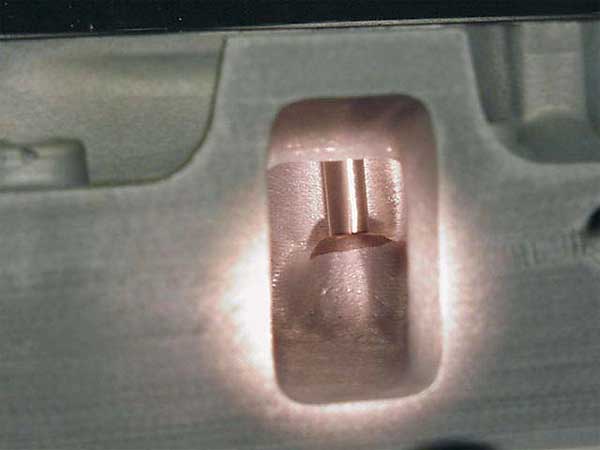 �
�
�
�
�
�
 �
�
� In conversations with Dale, it was decided to send a set of Olds heads up to him, so that he and � Dwayne could decide how best to make the heads flow to their full potential. I also sent a scrap � head for experimental work. A few weeks later, the revamped heads arrived back and they are gorgeous, � suitable for display on the living room coffee table! Through extensive machining, component selection � and porting, the heads are now capable of flowing enough air/fuel to keep the stroker well supplied. � The components are listed below:�
� • Intake Valves - Ferrea Racing Components p/n F6223 (Ford 2.3L) 1.74" head diameter, 11/32" diameter � stem, 4.800" overall length, 0.400" tip length�
� • Exhaust Valves - Ferrea Racing Components p/n F6224 (Ford 2.3L) 1.500" head diameter 11/32" diameter � stem, 4.800" overall length 0.400" tip length�
� • Valve Springs - Competition Cams p/n COM-901-16 (outer spring with damper) 1.500" O.D. 1.080" I.D. � 110 lb at 1.650" load at checking height, 290 lb@1.150" load at open height, 1.110 coil bind height�
� • Spring Retainers - Competition Cams p/n COM-743-16, steel (Chevy-Olds-Pontiac-SB Ford) 7 lock angle �
�
 �
�
�
�
Dwayne performed a baseline flow-bench test of the stock Olds head with stock valves. He then proceeded �
to develop the optimal port shape and size, performing three additional flow bench tests at various �
stages of the development.�
� • Test 1 - Stock Oldsmobile 8.75:1 aluminum head with stock 1.525" diameter intake valves and 1.350" diameter exhaust valves.�
� • Test 2 - Basic full port job, intake opened to 1.70" x 1.00", stock valves, 30 back cut on the valves, competition valve job.�
� • Test 3 - Basic full port job, intake opened to 1.70" x 1.00", 1.620" diameter intake valve, 1.400" diameter exhaust valve, both valves with 30 back cut, re-blended bowls.�
� • Test 4 - Basic full port job, intake opening to 1.80" x 1.00", 1.620" diameter intake valve, 1.400" diameter exhaust valve, both valves with 30 back cut, re-blended bowls, fully polished runners, more guide streamlining.�
� The final results showed an approximate 32 percent increase in intake flow and a whopping 54 percent in the � exhaust flow (both at 0.600" lift). �
��
�
��
�
� Disclaimer: This page was researched and written by Kurt Schley. Views expressed � are those of the author, and are provided without warrantee or guarantee. Apply at your own risk.�
�
�
� • Test 1 - Stock Oldsmobile 8.75:1 aluminum head with stock 1.525" diameter intake valves and 1.350" diameter exhaust valves.�
� • Test 2 - Basic full port job, intake opened to 1.70" x 1.00", stock valves, 30 back cut on the valves, competition valve job.�
� • Test 3 - Basic full port job, intake opened to 1.70" x 1.00", 1.620" diameter intake valve, 1.400" diameter exhaust valve, both valves with 30 back cut, re-blended bowls.�
� • Test 4 - Basic full port job, intake opening to 1.80" x 1.00", 1.620" diameter intake valve, 1.400" diameter exhaust valve, both valves with 30 back cut, re-blended bowls, fully polished runners, more guide streamlining.�
� The final results showed an approximate 32 percent increase in intake flow and a whopping 54 percent in the � exhaust flow (both at 0.600" lift). �
�
| EXHAUST - Tests corrected for 28" H2O | ||||||||
| Lift | Test 1 | Test 2 | Test 3 | Test 4 | ||||
| % | CFM | % | CFM | % | CFM | % | CFM | |
| 0.100 | 69 | 835 | 71 | 36 | 90 | 45 | 91 | 46 |
| 0.150 | 75 | 52 | 80 | 55 | 93 | 64 | 92 | 64 |
| 0.200 | 64 | 65 | 71 | 73 | 75 | 76 | 77 | 78 |
| 0.250 | 72 | 73 | 84 | 85 | 86 | 88 | 88 | 90 |
| 0.300 | 76 | 77 | 94 | 96 | 97 | 99 | 99 | 101 |
| 0.350 | 78 | 80 | 72 | 105 | 75 | 108 | 77 | 112 |
| 0.400 | 80 | 81 | 76 | 110 | 79 | 114 | 81 | 118 |
| 0.450 | 58 | 84 | 79 | 114 | 82 | 119 | 85 | 123 |
| 0.500 | 58 | 84 | 82 | 119 | 85 | 124 | 87 | 126 |
| 0.550 | 58 | 84 | 83 | 120 | 87 | 126 | 89 | 129 |
| 0.600 | 58 | 84 | 84 | 122 | 88 | 127 | 90 | 130 |
�
| INTAKE - Tests corrected for 28" H2O | ||||||||
| Lift | Test 1 | Test 2 | Test 3 | Test 4 | ||||
| % | CFM | % | CFM | % | CFM | % | CFM | |
| 0.100 | 63 | 43 | 69 | 48 | 74 | 51 | 74 | 51 |
| 0.150 | 62 | 63 | 70 | 72 | 76 | 77 | 76 | 77 |
| 0.200 | 84 | 85 | 66 | 95 | 72 | 104 | 72 | 104 |
| 0.250 | 72 | 104 | 76 | 111 | 88 | 128 | 88 | 128 |
| 0.300 | 80 | 116 | 85 | 124 | 81 | 146 | 81 | 147 |
| 0.350 | 84 | 122 | 95 | 138 | 88 | 159 | 89 | 161 |
| 0.400 | 71 | 128 | 83 | 150 | 93 | 168 | 95 | 172 |
| 0.450 | 73 | 133 | 87 | 158 | 93 | 168 | 95 | 173 |
| 0.500 | 74 | 134 | 91 | 165 | 94 | 170 | 96 | 174 |
| 0.550 | 75 | 136 | 93 | 168 | 95 | 173 | 97 | 176 |
| 0.600 | 75 | 136 | 93 | 168 | 95 | 174 | 98 | 178 |
� Disclaimer: This page was researched and written by Kurt Schley. Views expressed � are those of the author, and are provided without warrantee or guarantee. Apply at your own risk.�

